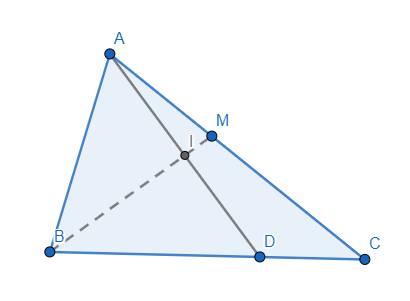Giúp tui :v
Bài 1 : Cho hình chữ nhật ABCD có AB = 2a,AD = a.Tính độ dài vecto AB + vecto DB
Bài 2 : Cho tam giác ABC gọi I là trung điểm trên cạnh BC sao cho 2CI=3BJ,J trên cạnh BC sao cho 5BJ=2CI.Phân tích vecto AI và AJ theo hai vecto AB,AC
Hãy nhập câu hỏi của bạn vào đây, nếu là tài khoản VIP, bạn sẽ được ưu tiên trả lời.

Xét ΔBAD có BI là đường trung tuyến
nên \(\overrightarrow{BI}=\dfrac{1}{2}\left(\overrightarrow{BA}+\overrightarrow{BD}\right)\)
=>\(\overrightarrow{BI}=\dfrac{1}{2}\left(\overrightarrow{BA}+\dfrac{2}{3}\overrightarrow{BC}\right)\)
\(=\dfrac{1}{2}\left(\overrightarrow{BA}+\dfrac{2}{3}\overrightarrow{BA}+\dfrac{2}{3}\overrightarrow{AC}\right)\)
\(=\dfrac{1}{2}\left(\dfrac{5}{3}\overrightarrow{BA}+\dfrac{2}{3}\overrightarrow{AC}\right)\)
\(=\dfrac{1}{2}\cdot\dfrac{1}{3}\left(5\overrightarrow{BA}+2\overrightarrow{AC}\right)=\dfrac{1}{6}\left(5\overrightarrow{BA}+2\overrightarrow{AC}\right)=\dfrac{5}{6}\left(\overrightarrow{BA}+\dfrac{2}{5}\overrightarrow{AC}\right)\)
\(\overrightarrow{BM}=\overrightarrow{BA}+\overrightarrow{AM}\)
\(=\overrightarrow{BA}+\dfrac{2}{5}\overrightarrow{AC}\)
=>\(\overrightarrow{BI}=\dfrac{5}{6}\cdot\overrightarrow{BM}\)
=>B,I,M thẳng hàng

Cách 1: Dùng định lý Menelaus đảo:

Từ đề bài, ta có \(\dfrac{BD}{BC}=\dfrac{2}{3}\), \(\dfrac{MC}{MA}=\dfrac{3}{2}\), \(\dfrac{IA}{ID}=1\)
\(\Rightarrow\dfrac{BD}{BC}.\dfrac{MC}{MA}.\dfrac{IA}{ID}=1\)
Theo định lý Menelaus đảo, suy ra B, I, M thẳng hàng.
Cách 2: Dùng vector
Ta có \(\overrightarrow{BI}=\dfrac{1}{2}\left(\overrightarrow{BA}+\overrightarrow{BD}\right)\)
\(=\dfrac{1}{2}\overrightarrow{BA}+\dfrac{1}{2}.\dfrac{2}{3}\overrightarrow{BC}\)
\(=\dfrac{1}{2}\overrightarrow{BA}+\dfrac{1}{3}\overrightarrow{BC}\)
\(=\dfrac{1}{6}\left(3\overrightarrow{BA}+2\overrightarrow{BC}\right)\)
Lại có \(\overrightarrow{BM}=\dfrac{MC}{AC}\overrightarrow{BA}+\dfrac{MA}{AC}\overrightarrow{BC}\)
\(=\dfrac{3}{5}\overrightarrow{BA}+\dfrac{2}{5}\overrightarrow{BC}\)
\(=\dfrac{1}{5}\left(3\overrightarrow{BA}+2\overrightarrow{BC}\right)\)
\(=\dfrac{6}{5}.\dfrac{1}{6}\left(3\overrightarrow{BA}+2\overrightarrow{BC}\right)\)
\(=\dfrac{6}{5}\overrightarrow{BI}\)
Vậy \(\overrightarrow{BM}=\dfrac{6}{5}\overrightarrow{BI}\), suy ra B, I, M thẳng hàng.

\(\overrightarrow{AM}=\overrightarrow{AB}+\overrightarrow{BM}=\overrightarrow{AB}+\dfrac{2}{5}\overrightarrow{BC}\)

Lời giải:
Kẻ tia $AL$ đối tia $AB$ sao cho $AB=AL$. Từ $L$ kẻ $LK\perp DC$
\(|\overrightarrow{AB}+\overrightarrow{AC}|=|\overrightarrow{LA}+\overrightarrow{AC}|=|\overrightarrow{LC}|\)
\(=LC=\sqrt{LK^2+KC^2}=\sqrt{BC^2+BL^2}=\sqrt{BC^2+(2AB)^2}=\sqrt{(4a)^2+(2.2a)^2}=4\sqrt{2}a\)

Bài này bạn đã đăng tại đây:
https://hoc24.vn/cau-hoi/cho-hinh-chu-nhat-abcd-co-do-dai-canh-ab2a-bc4atinh-do-dai-vecto-abvecto-ac.2659817639735

a: \(\overrightarrow{CN}=\dfrac{1}{2}\overrightarrow{CA}+\dfrac{1}{2}\overrightarrow{CB}\)
\(=\dfrac{1}{2}\overrightarrow{CB}+\dfrac{1}{2}\overrightarrow{BA}+\dfrac{1}{2}\overrightarrow{CB}\)
\(=\dfrac{1}{2}\overrightarrow{u}-\overrightarrow{v}\)
Bài 1:
Gọi M là trung điểm của AD
\(BM=\sqrt{AB^2+AM^2}=\sqrt{4a^2+\dfrac{1}{4}a^2}=\dfrac{\sqrt{17}}{2}a\)
\(\left|\overrightarrow{AB}+\overrightarrow{DB}\right|=2\cdot BM=\sqrt{17}a\)